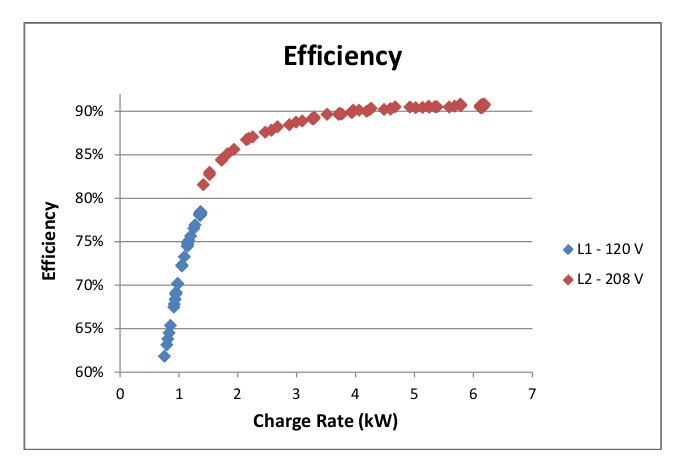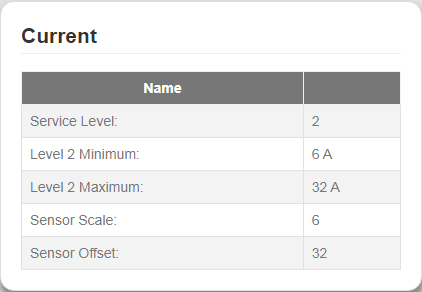I have an excellent systen for changing my EV’s that uses a Pi zero to read the output of my PV and on seeing 1.5KW sends MQTT commands to an EVSE to begin charging. The Pi zero ensures the charge current tracks the Solar output and shuts the charging down when the solar output falls below 1.2KW for 10mins.
My issue us that I’m not able to charge under 6amps, so I am missing out on availeble charging. I don’t particularly want to invest in an AC coupled battery system as a solution, when all I really need to do is charge at lower currents… but can’t as SAE J1772 doesn’t allow for it. The only solution I can see is to run the EVSE on a 110V transformer which will mean I can start charging at 3A.
I haven’t tried it yet… any thoughts anyone?
The lowest supported current by J1772 protocol and the onboard charger in the EV is 6A which is approx 1.4kW at 240V.
In the USA on level 1 110V 6A would be approx 0.660kW, (assuming your European spec EV’s onboard supports 110V) then I guess you could use a 240V:110V transformer, however efficiency of charging will be terrible. Ignoring the losses in the transformer, the onboard charger efficiency at level 1 6A is about 60%:

I think you would be better off diverting low power solar PV to something like a hot water immersion tank.
Update: The European spec OpenEVSE’s use a 240V contactor, therefore this will need swapping out in favour of the DC contactor used in USA spec OpenEVSE f you want to run it on 110V.
110 V is a holdover from the 60s.
North America uses a 120-0-120 Volt system. That would make the power calc approximately 0.720 kW
Minor difference I know, but no point in spreading outdated info.
It is also the standard UK voltage for portable tools on construction sites - as 55 - 0 - 55 V, which is most likely what @glyn.hudson was thinking of.
As indeed the ‘Learn’ article here explains, which of course we co-authored.
and yes, I was considering using a readily available 230 V to 110V power tool isolating transformer as the supply, with some form of switch over from 230V for PV power of < 1500W. All a bit messy and problematic.
The best solution is that the J1772 protocol is changed to allow currents down to 1A. Most domestic PV installations in the UK are around 2KWp, ( I’m installing numerous 1KWp installations on new builds), so a lot of energy will be going back into the grid particularly where there are combi boilers installed. …but I’m not going to hold my breath!.
I guess its the AC storage solution for me, probably a Solis G98 3KW AC Charger and a pylontech 2.4KWh battery coming in at around £1000 + VAT. As G98 I can use the DNO G98 Energy Storage Fast Track Connection Form for connecting Small Scale Energy Storage Schemes. This will act as a buffer for the low PV generation. I will need a bit of code to couple it all together…
…just something else to do as the nights grow darker!
I have a similar issue. Even with 10 kW peak of installed PVs and a 5kVA SolarEdge hybrid inverter - no batteries - I am putting my solar energy in the grid instead of the car during winter.
I did consider batteries, but these are too expensive still. I now have a good deal with ENECO that gives me a good price for injected power, so that does not help the business case for the battery. I don’t know what Europe will do with electricity pricing, so that business case may shift.
Taking energy from the grid costs more per kWh than what I get for export. So there is a break even for keeping the OpenEVSE charging the car while having to import a bit to make up till 6 Amps. That is what I do in winter. I offset the Power1 calc to that break-even value. Would be nice if OpenEVSE could do that straight. I’m not sure that the parameter " Required PV power ratio" is intended for that function.
Anyways, I will need some custom code for putting the offset at the correct value so it can follow changing electricity prices.
What cars do you have? It may be possible to do it via car’s API.
I just got Tesla Model Y. I have managed to trickle charge at 1 Amp and fully utilise my 2.8 kWp array during a not sunny day (today, London).
(the 7 kW peaks are due to me tweaking the turn-on automation and it failed to correctly set charging amps)
Done via Home Assistant and Tesla_custom integration, data from emonCMS.
Peugeot e-208.’
It is OpenEVSE that limits the charge current to 6 Amps, not the car:

